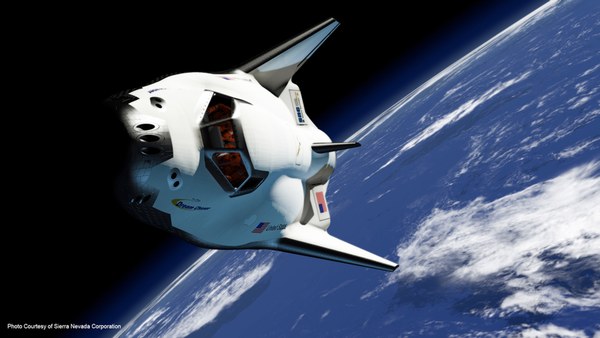[Editor’s Note: The following report from last week’s AIAA Space 2014 conference in San Diego is by Duane Hyland.]
Sierra Nevada Corporation’s (SNC) Dream Chaser spacecraft is “on track for its anticipated first launch in November 2016,” Mark Sirangelo, corporate vice president of SNC Space Systems, told a press conference on August 5 at the AIAA SPACE 2014 Forum in San Diego.
Sirangelo explained “that the first launch, out of Florida’s Space Coast, would be one of two required for certification of the spacecraft, and will be unmanned.” The second launch, scheduled for November 2017, would be manned and piloted.” Sirangelo told the audience that “the tests are on track, and that the launch slots have been obtained.” He noted that SNC would fly “five test flights of Dream Chaser, with three of them being manned, in order to by fully comfortable with the craft’s ability to carry humans into space.”
Sirangelo also reaffirmed that the vehicle would use the Atlas V rocket to launch, confirming that SNC was staying with the vehicle despite ongoing concerns about ability to obtain the rocket’s RD-180 engines from Russia in light of current geopolitical concerns. Sirangelo explained that they selected the Atlas V because of its heritage. “We don’t want to worry about the design and structure: it will be over 50 flights and close to 60, by the time we put humans on board,” he said.
Sirangelo also noted that SNC “owns the Atlas Vs that will be used for launch,” so that would be another reason not to worry about the possible disruption to the RD-180 supply. However, he noted that Dream Chase “is agnostic, it can fly on any system, so we are not wedded to the Atlas V,” suggesting some flexibility should the anticipated supply shortage become a reality.
When asked if the Atlas V would need extensive retrofitting to carry the vehicle, Sirangelo said, “It’s a whole lot less complicated than you would think,” specifying that that “the vehicle interface, which will link the craft to the Atlas V rocket, is being built now.” He added that after the interface, the next needed item for launch is “an emergency detection system, required to let the crew know if there is a problem that requires the flight to be aborted.” Once both the interface and emergency detection system are in place, Dream Chaser will be ready to fly on the Atlas V.
Sirangelo also expressed confidence in the craft’s unique lifting body, saying that there is a multitude of capsule-based vehicles right now, ranging from the existing vehicles that support the ISS to NASA’s Orion spacecraft. “In that complex world, we think that having a lifting body has a real practical purpose.”
Asked if there was a risk of Dream Chaser’s exclusion from the next phase of NASA’s commercial crew program, Sirangelo said he was not worried. “Now is a great time for rumors, but I think from what we see it will be multiple companies and vehicles,” he said. “Practically speaking it would be difficult to make that downselect now: we are the only one starting to fly real hardware, but we are a long way away from a real final decision on the program.”
Sirangelo closed the press conference by discussing Dream Chaser’s unique abort system. “It’s one of the things we really spent a lot of time on, and is one of strongest parts of the design,” he said. Triggered at any time during the launch sequence, Sirangelo said the system allows the vehicle to “fly off the stack, abort, and land at a facility a few miles away, or on any standard runway capable of handling a Boeing 737.” The system also acts as ancillary propulsion on orbit, allowing greater maneuverability, and the ability to perform missions like satellite repair with greater precision. If the motors are not used, their non-toxic fuel is simply vented out before the craft’s return to Earth.


I know that this may be a frivolous comment but that’s one really sexy looking spacecraft. On looks alone, it’s a winner.
Best of luck to SNC.